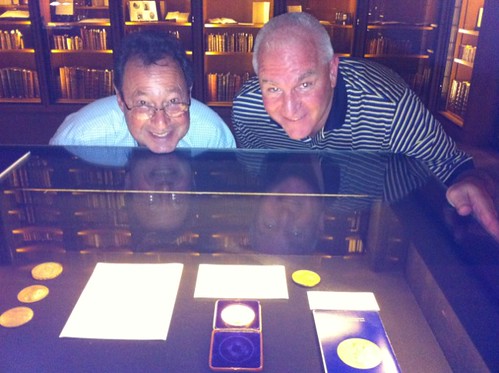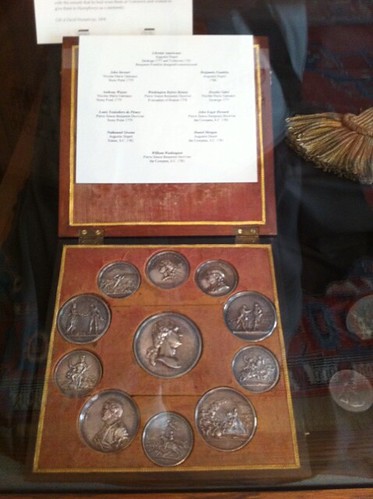
PREV ARTICLE
NEXT ARTICLE
FULL ISSUE
PREV FULL ISSUE
ALAN WEINBERG ON THE 2010 BOSTON ANA CONVENTION
Alan V. Weinberg submitted the following discussion of his experiences at this week's ANA convention. The images are courtesy of
Nathan Markowitz, who accompanied Alan and Dave Perkins to the Boston Public Library and Massachusetts Historical Society. Thanks!
-Editor
You'd think that after approximately five decades of attending summer ANA conventions I'd be a bit jaded and unenthusiastic about the massive gathering. But no - Boston was extremely enjoyable and rewarding for me. I saw things I'd never seen before, acquired some goodies, renewed old friendships and certainly continued to learn a lot, which is one of the really uplifting things about numismatics - you never stop learning. One thing that was clear: there is definitely a renaissance of collector interest in the 19th century popular pursuits of collecting colonial coins, historical medals and oldtime traditional numismatics. I believe that the authoritative and enjoyable Stack's John Ford catalogue series started this re-awakening, together with the pursuit of one point upsmanship of plastic slab grading and the absurd differences in value in the higher mint state grades of federal coinage.

Dave Perkins and Alan Weinberg at the Boston Public Library viewing the gold Washington Before Boston medal From Marc Salzburg's exhibit at NGC of his own superb Massachusetts silver coinage type set (naturally in NGC slabs), to Stu Levine's multi-case bourse floor exhibit of his Comitia Americana medals, to Dave Sundman's profound exhibit of his own Massachusetts colonial silver, to Rex Stark's 1st prize-winning exhibit of immaculately enameled Morgan and Trade dollars (oh, that full face Wm H. Taft enameled dollar!). And Dick Margolis' splendid array of 18th and 19th century Benjamin Franklin portrait medallions (a specialty of his for decades), John Sallay's seven-case exhibit of gold and silver school medals, many with incredible hand-engraved vignettes, to Tony Terranova's 1/2 bourse table offering of rare medals, to the heavy attendance viewing, over a week's time, of the Washington Before Boston original gold medal at the nearby Boston Public Library and the even more jaw-dropping medallic exhibit at the nearby Massachusetts Historical Society, there is definitely a substantial drift away from slabbed Morgan dollars and St Gaudens $20 gold pieces and even early type gold which can be seen at silly prices in bourse table after bourse table and really present no challenge except money.. This change in American numismatic appetite is abetted by the publication of delightful new reference books, following the Stack's Ford sales catalogues, such as John Adams' just-published Admiral Vernon medals book, Dave Bowers' American colonial coin encyclopedia, Eric Newman's new colonial currency book, Jaeger/Bowers' 100 Greatest American Medals and Tokens, George Kolbe's auction catalogues of the Ford and Stack's Family libraries, George Fuld's book on Washington Getz patterns, Coin World's prolific articles on the more obscure and historical items of American numismatics to Rory Rea's about-to-be-printed superb color plate book on bust quarter varieties.


Washington Oregon and Happy While United medals Some things I saw at the ANA: John Kraljevich's land office business at his bourse table in an obscure part of the 2nd room of the bourse - not a U.S. federal coin in sight there - but rare and delightful tidbits including a momentary glimpse of an "out-of-the-woodwork" superb silver Libertas Americana medal before it quickly sold for a solid six figures; Joe O'Conner's for-exhibit-only 1799 bust dollar as it would have looked dropping from the dies- I'm reliably told it equals the very best of Eric Newman's bust dollars; PCGS' bourse display of numerous gem proof - many red - half cents and large cents; the single decent grade "out-of-the-woodwork" 1793 Ameri. chain cent on the bourse floor, an EAC grade net VG-10 newly slabbed VF-20 selling for $40K; a middle grade 1652 New England NE shilling auctioning for a record-breaking total $431,500; a breathtaking $103,500 for a superbly leather-bound 1859 Geo. Washington portraits - a massive non-numismatic tome with an oval gold Jacob Perkins GW funeral gold medal under glass embedded in the cover selling to a Texas dealer reportedly representing a well-known Texas numismatic family; Jeff Shevlin's so-called dollar "sealed bid" Ostheimer I auction, a resounding success with some bids reduced in the multi-thousands of dollars. Both Larry and Harvey Stack, now retired, were present walking on the bourse floor and you don't know realize how much they have been missed from the hobby until you see them. And in 55 years of collecting I think that the highlight (apart from attending all of the John Ford Stack's auctions), was my visit to the Massachusetts Historical Society, where curator Anne Bentley (an unusual museum curator in that she has enthusiasm for collectors & an intense interest and knowledge of the numismatic contents of MHS' Appleton and Storer, etc collections) and collector/author John Adams mounted a one-time multi-cased exhibit of the rarest and superbly conditioned American medals I've seen.

George Washington's set of silver Comitia Americana medals WOW! Such as a gold George Washington Manly original striking, a dreams-are-made- of 1764 Geo. III Happy While United silver peace medal, the original cased set of Comitia Americana silver medals presented to George Washington and later owned by Daniel Webster - minus the silver John Paul Jones medal which was lost in postal transit and reportedly even discarded with shipping materials! And a unique 1652 NE threepence. But, for me and perhaps E-Sylum readers, a supreme highlight was collector Charles Anthon's "souvenir" hand-engraved 1867 seated dollar with a reverse engraved inscription celebrating Anthon's heavy buying at the Woodward Mickley auction. What numismatic history! Sadly, MHS' own Massachusetts silver colonial coinage is "bare bones" due to a prior curator unwisely auctioning their Massachusetts colonial silver coinage to raise building funds in the early 1970's. Perhaps a collector reading this will correct the situation so that his name will live on in history as Appleton's and Storer's does. However, there were some negatives about the show: A second bourse room, walled off from the normal collector traffic flow and the "main" bourse room which was, throughout the show, notably less-well attended. There had to be repeated public address announcements that there was a 2nd bourse room and still that didn't work as the main entrance "tunnel" to the 2nd bourse room was visibly blocked by a huge ANA and Smithsonian exhibit and that's all you initially saw as you walked thru the "tunnel". Most dealers I spoke with in both bourse rooms bitterly complained that the solid room wall separating the two bourse rooms was not clearly evident on the contract map and verbally "minimized" when bourse dealer inquiries came in about this 2nd bourse room. ANA's traditional Sunday bourse closing is now closing on Saturday resulting in perhaps 40% of the dealers closed and gone by 3 PM Saturday. The two pre-ANA's were pretty much a waste of time in my experience and according to just about everyone I spoke with, the Aiello Radisson show being somewhat more interesting and collector-oriented. Which probably does not prove promising for next year's Chicago ANA-sponsored "pre-ANA dealers -only" show. PNG Day was much too long- it normally ranges from 10 AM to 3 PM with ANA bourse set-up starting at 4 PM but PNG Day was a full day in Boston. Which cut down on ANA bourse hours - that bourse opening at 1 PM the following day instead of the normal 10 AM - in addition to Sunday being eliminated. The ANA exhibits in two rooms were largely superb in content but miserably lighted along the exhibit room walls - Rex Stark's enameled dollars, perhaps deservedly first place, were in almost total darkness while in the center of each exhibit room an entire row of empty tables (for lack of more exhibitors such as I) sat totally and embarrassingly empty but extremely well-lighted. What was the exhibit chairman thinking? Speaking of lighting, what was the ANA thinking when the C4-sponsored colonial coin exhibit, including two superb New York City collections which included a superb Standish Barry 3d , an Unc Excelsior 1787 cent and an Unc American Congress Fugio cent, were simply not viewable in dark, unlighted display cases which only needed clip-on lamps? So many people negatively commented on this. A bourse floor "dust-up" between two New York City longtime foe numismatic dealers which was quickly and quietly moved outside by Brueggeman security. Sadly (but inevitably as all things change), longtime ANA Convention Coordinator Brenda Bishop is leaving her ANA employment this week for a new career in health industry expos, for a higher salary and less stress and work. The choice of venue - Boston - is one of the most delightful cities I've ever visited. Wonderful eating opportunities, great museums, great public transportation, parks, a centrally -located lake, beautiful and plentiful college girls (yes, I still look!) and a thriving restaurant and bar nightlife. The Sheraton was nice and connected to a food court with an inexpensive Au Bon Pain restaurant, the site of delicious and varied breakfasts and lunches by numerous ANA attendees and dealers. Anyone who ate the overpriced convention center food ... Makes you wonder why this is only the 3rd ANA convention in Boston since 1973. A wonderful week steeped in numismatics!
We wish the best of luck to Brenda Bishop, a true workhorse for the association over many years. She will leave behind a big pair of shoes to fill. Pulling off a convention is not a task for the lighthearted - it takes a Herculean effort to bring all the pieces together.
Thanks again to Alan, Joel, Dick, Dennis and Pete for their great accounts of the show, and Nathan and Dan for their excellent photos. Let's hear from more of you next week - what were other highlights from a numismatic literature and research standpoint? -Editor THE BOOK BAZARREA FEW UPCOMING SEPTEMBER 16, 2010 AUCTION HIGHLIGHTSClassic Original Die Studies on Ancient Greek Coins, Including:
(614) 414-0855 • df@numislit.com • GFK@numislit.com Wayne Homren, Editor The Numismatic Bibliomania Society is a non-profit organization promoting numismatic literature. See our web site at coinbooks.org. To submit items for publication in The E-Sylum, write to the Editor at this address: whomren@gmail.com To subscribe go to: https://my.binhost.com/lists/listinfo/esylum All Rights Reserved. NBS Home Page Contact the NBS webmaster 
|